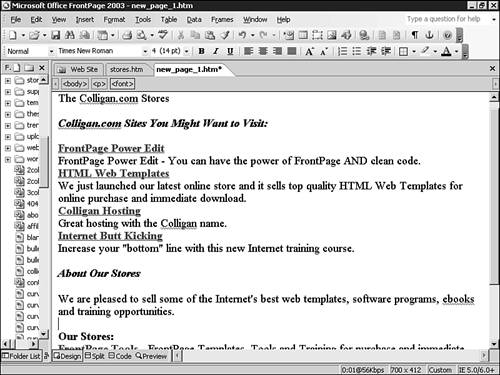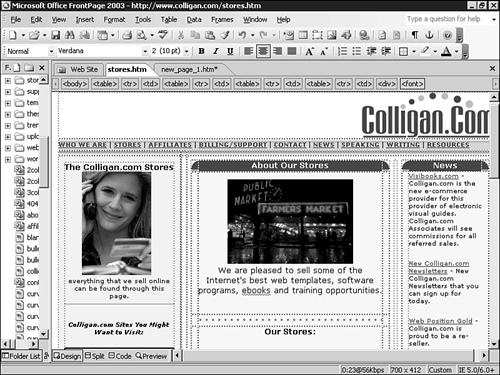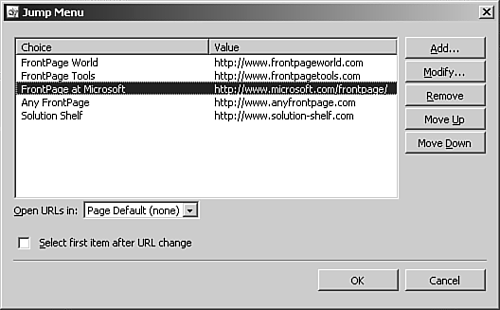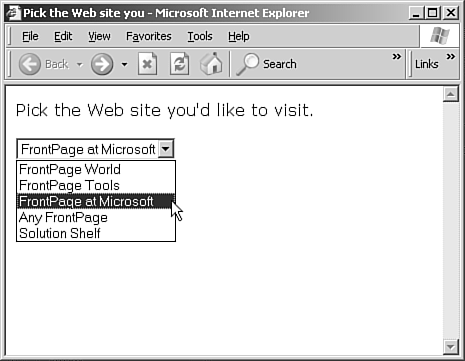Developing the Team
| Putting together the right team is key to any collaborative effort. The right team is made up of willing participants with the right talents that enable them to get the job done. More than anything else, developing the team requires a solid understanding of the project at hand. Participants should be chosen in light of their abilities in relation to the project requirements. All too often, a Web site has been designed with far too many artists or programmers, without the necessary qualified writers and content editors. Choose your team based on what is needed, not based on a preconceived notion of how many people should be on the team. FrontPage 2003 provides a series of tools and capabilities that make the development of a team-based site easier than it has ever been before. A solid understanding and proper implementation of these tools can make the process as painless as possible. In this chapter, we'll look at the technological and personal aspects that must integrate into any team-based Web development project. We'll look at the people who should make up any team and look at the technology that provides the means to manage them and their project. Choosing ParticipantsBringing a lot of people into a Web-based project might seem like a good idea. Many managers decide that everyone can be a part of the project when the only thing required is access to the Web site (or even corporate network). This reasoning is never a good idea. In the same way that too many cooks spoil a soup, an oversized team can work a project into the ground. The meetings and planning sessions that exponentially multiply with the size of a group seldom do more than get in the way. Like any other project, a collaborative Web-based effort needs to have a clear beginning and end. Effective leadership is required to move the project from concept to completion. Including everyone in the process will most likely keep both from occurring. At the same time, beware of thinking that you need fewer people than you do. There is a common misunderstanding in Web design that just because you can, you should. Sometimes subtlety and brevity work better than any fancy graphic or layout ever can. TIP No matter how wonderful the tool, an understanding of what to do with the tool is always more important than having the tool. Be careful with participants who think that because they have a graphic program, they suddenly are artists; be careful also of those who believe they can suddenly program now that they have FrontPage Wizards at their disposal. As mentioned in the previous chapter, FrontPage 2003's reporting features provide a number of valuable options for tracking the movement and progress of the teams. Use these reports on a regular basis to understand and react to what your participants are doing. They compose a very powerful toolbox for understanding your project's status in its entirety. Talents to Seek OutSeven talents are required for a successful collaborative Web-based project:
A single person obviously can provide more than one talent. It also goes without saying that some talents are important enough to require multiple participants. The best collaborative team blends these talents. TIP The ability to work with a team is an obvious but often disregarded requirement for anyone participating in a collaborative online effort. Don't assume that just because someone spends his time in front of a computer, he lacks people skills. Nothing slows a team project more than someone who doesn't work well with others. ContentThe ability to create clear and concise content is one of the most overlooked talents in a collaborative project. All too often, people assume that anyone who has a keyboard in front of him can create good content for the site. This is simply not the case. Understanding what to present does not come naturally to everyone. Team members will sometimes use a Web site as a dumping ground for every piece of information available. Key elements will at other times be missing because it is assumed that "everyone knows that." Nothing frustrates a user faster than a Web site lacking the information he is looking for. Get someone who has an understanding of content presentation. English majors, copywriters, and communication specialists are always a good place to start. Many times, it is the same people who write your marketing or training material who should be brought into that part of the project. The type of content required for intranet projects can be very different from traditional copy sources. This content often contains phrasing and slang understood by the company but that is Greek to the outside world. This is understandable, but it needs to be carefully monitored; the documents one day might be ported to a traditional Internet or extranet, which might be viewed by individuals unfamiliar with the corporate lingo. The audience for any project must be clearly understood before the first line of copy is written. "Content is king" remains a popular Internet catch phrase. Without good content, the rest of the site isn't worth much at all, so be sure your people in charge of content understand that. LayoutA firm understanding of Web design layout requirements is mandatory whenever a site is being created. This is especially important in a collaborative effort; as you divide the project into manageable pieces, it will become even more important to trust that the other participants are completing their ends of the project. Someone who writes good copy or codes database searches well should not be expected to understand how his work will look on various platforms. As can be seen in Figure 31.1, lousy layout can have the effect of overshadowing fabulous content. Figure 31.1. Although the content might be great, an unattractive layout prevents the reader from ever getting to that content.
To put things simply, someone with skills for layout simply has an "eye" for it (usually trained by a lot of experience). He must understand the maximum amount of words that should be onscreen at any one time and has the ability to place them together in a way that is pleasing to the eye. He knows how to create a look and feel that flows through the entire site. It is obviously best if he has worked on a Web site before. Figure 31.2 shows how good layout can help direct the user in whatever direction you want him to go. Figure 31.2. Good layout directs the eye to the content and leads the reader along. Compare this to Figure 31.1.
Often, the person with the layout talent should be one of the first involved in the development process. FrontPage 2003's template capabilities can help prevent some layout mistakes made by the uninformed or the overly zealous, but those capabilities should never take the place of team talent on a large project. Graphic SkillsGraphic skills require more than the ability to use the graphics programs available to the group. An eye for aesthetics and an understanding of the requirements and limitations of a screen-based presentation are required for anyone who is put in charge of the graphics and images for the site. It might seem that everything is different on the Internet, but this is seldom the case. Many of the same skills taught to and understood by traditional graphic designers can be used in a Web environment. The effect of certain colors on mood or the impact gained from a certain font can help make a powerful Web project. Go for the "eye" first if you must decide whom to assign to layout. Someone in charge of layout or content can always manipulate the users' work so that it can be presented online. The graphics chapters in this book can help walk you through that process.
Programming CapabilitiesIn the life of a Web-based project, programming skills are sometimes required. They might not be required in the beginning, but the chances of programming becoming necessary at some point are too strong to ignore. In addition, the reality is that many Web project requirements can be better performed via a program rather than traditional HTML. If you understand the options, you can make the best decision. In short, FrontPage is not always the right tool for Web design it is simply my favorite. Someone should be available from the project's beginning who can help you determine whether (and when) programming will ever be needed. Even if you think you don't need a programmer immediately, you should have one available for both project consulting and possible later use. No one knows better than a programmer when a programmer is needed. TIP Programming must be approached carefully in Web-based projects. In traditional programming, the developer can control considerably more than he can on the Web, and this reality is sometimes lost. Make sure that your programmer understands that he has no control over system, OS, browser type, screen size, and also can't be assured that the top plug-ins are installed or that they are even allowed on the desktop of the user. Scripting is the first type of programming you will see in a Web project. In this approach, the programmer writes scripts (on either the server or client side) that interact directly with the data or the user. Typical examples of this programming type include reactions to mouseovers and direct responses to entered data. Scripting typically is accomplished in DHTML, JavaScript, or VBScript. JavaScript and VBScript should never be confused with their executable-based Visual Basic or Java counterparts. Behaviors, new to FrontPage 2003, provide limited client-side scripting options to your site with just a few clicks of the button. In some cases, you won't need to code a thing, but having someone who understands scripting will let you further define the behaviors. In Figure 31.3, the Jump Menu behavior dialog box is shown. Entering the desired choices and value will produce a scripted jump menu, seen in Figure 31.4. Figure 31.3. The Jump Menu dialog box lets you set variables without scripting.
Figure 31.4. The Jump Menu behavior is an example of client-side scripting.
You also can optionally use server-side scripts (scripts that are stored and executed on the server). Such scripts result in HTML being written based on user input or other external data sources. This typically is used when the user is searching information in a database and HTML code has to be written on-the-fly to respond to the search. Active Server Pages (ASP) is one of the most popular implementations of server-side scripting. Because it doesn't require program execution, scripting is one of the most popular practices for Web-based programs. If your programming requirements can be accomplished via scripting, you should use it. The second type of programmingis more traditional. It results in individual programs that run in conjunction with the Web browser or server. These can be found in the form of traditional .exe executables, Java programs, and COM controls. When looking for a programmer, bring someone to the team who can program in Visual Basic and VBScript for Microsoft-specific projects or C++, Java, and Perl for more universal applications. Be sure that you hire someone who understands both programming approaches and understands when to use each. If you don't know enough about programming to make a good decision, bring on board someone who does. You also should use programmers who use additional software tools. Although programmers will have to code something by hand at some point, the assistance given by such tools almost always speeds the development process. Beware of programmers who say that they don't need additional development tools: They sometimes separate themselves from the tools because they fear being replaced. The third programming skill that shouldn't be overlooked is the ability to develop FrontPage macros with VBA. Many times a certain project or team will need the same basic function over and over again and quick macro developed by someone proficient in VBA could save untold hours.
Data ManagementWeb sites often contain tremendous amounts of data. Whether it is in the form of a database or hundreds of pages of copy, the amount can sometimes be overwhelming. Making sense of all the data is an important skill set for successful Web design. Sometimes site data management requires more than effective layout skills and an understanding of flow. Someone on the team needs to understand and be able to manipulate the amount of data presented at the site. The requirements are minimal if the amount is relatively small. Having a person skilled in data management is always a good idea, however, if the amount of data is as large as is typical to intranet and extranet applications. TIP Sometimes the requirements of a Web site seem capable of being met through traditional HTML. If the amount of data contained on the site is expected to grow on a regular basis, you should examine whether the site could best be designed and implemented via a database-driven interface. Obviously, FrontPage is not the only tool used in such an approach. Informational FlowUnderstanding (and controlling) how the information flows from one page of the site to the next is mandatory for an effective site design. This concept is discussed in greater detail in the first two chapters of this part and should be reviewed if necessary. Either an individual or a tightly knit team should be responsible for how the project's information flows. The larger the number of people working on the project, the better the chance that the content will be haphazardly thrown together. This must be prevented. Someone often meets this talent need with previous site design and Web building experience. Chances are good that he will have made mistakes in the past and can bring his current knowledge to the project. The larger the site he has worked with in the past, the more experience he has with issues of informational flow. The type of person required is someone who understands the site as an entity as well as understands how everything relates to everything else. These are certainly "big picture" people who see things in terms of the site instead of the Web page. Management SkillsSomeone must manage the project. Introducing a new leader to the perils of command when working on a collaborative Web project is never a good idea. The person in charge of the project should have some past management experience and should enjoy working with people; he will work with others more often than anything else. All the clichés in this case are true: You will want a people person with good communication skills. Someone with previous online or computer-based management experience is especially desirable. Someone with the experience of communicating with a team via email (or other forms of electronic communication) will have an advantage. Anyone who has used a computer system to track his progress is in the right location as well. Division of LaborDividing the work among your team members is always easier said than done. Expecting everyone to complete his work in such a way that no one else in the group is adversely affected is nothing short of wishful thinking. Because the relationships between various elements in every Web are so interconnected, great care must be taken in dividing the tasks between the team members. The best way to approach the division of labor problem is to divide the project into smaller tasks, as many as you can. If at all possible, design the project so that everything comes together as late in the process as possible. Follow each of the teams as they complete their tasks and ensure that they follow some kind of schedule. It is often wise to have content developed independently of the rest of the site. Upon completion, the content can be added to the final product without requiring constant revisions. Putting placeholders in a Web project is no problem. Filling pages with dummy text or a database with multiple copies of the same entry is fine in the initial stages. Placing "graphic goes here" placeholders on the pages is also completely acceptable until your site goes live, of course. |
EAN: 2147483647
Pages: 443


 Help on the art of using graphics with Web design can be found in Part X, "Creating and Adapting Graphics for the Web,"
Help on the art of using graphics with Web design can be found in Part X, "Creating and Adapting Graphics for the Web," 
